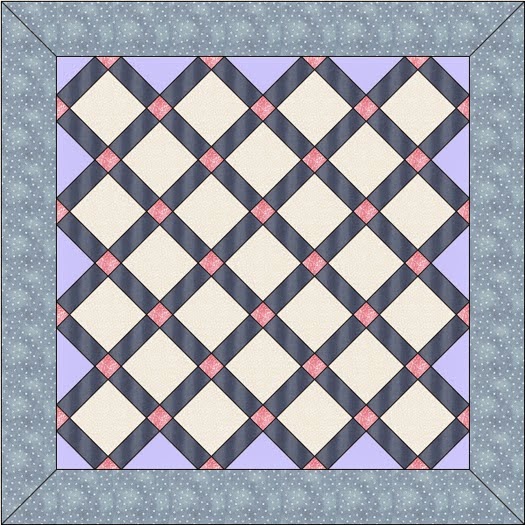Repro Block: By Ddwgram
What's your favorite color?
This week mine is Prussian blue!
Vintage quilt, date-inscribed 1850
Prussian blue dyed both the dark blue ground and the lighter shades in the figures above. The contrasting color was often a tan called buff.
Wishful thinking.
It's not too late to get caught up in a mid-19th-century madness---160 years later.
Repro Block By Shawn
Repro Block by Becky Brown
Over at my Civil War Quilts blog I'm doing a free online class in reproduction fabrics in the form of a QuiltAlong. Week 2 in Stars in a Time Warp featured Prussian Blue.
Vintage quilt, 1840-1860
Prussian blue is a mineral dye that could color both figures and grounds a wide
range of blue. In the 1840s and '50s there was a rage for bright blues in
clothing and quilts.
Vintage block, mid-19th century
The other blue commonly seen in antique quilts is indigo blue,
which generally lacked Prussian blue's brilliance.
Mid-19th-century quilt auctioned at Sotheby's
Indigo is much more conservative in color.
Repro Block: Amy
Repro Block: Valerie
Reproduction block by Anita Lozcalzo,
made for a group project.
Anita Lozcalzo loves Prussian blue too. Her exhibit A Passion for Prussian Blue focuses on this brilliant dye. See it at the New England Quilt Museum before April 4, 2015.
Vintage quilt
Prussian blue sashing was quite the thing in the 1840s & '50s.
Here's a detail of a vintage quilt from the NEQM show. The maker
thought the Prussian blue sashing was so stylish
she didn't need patchwork anywhere else.
Repro Block by Ddwgram
Repro Block by VictoriaCarroll
Repro Block by SF
Vintage quilt--Note the range of blues---blue-violet
to almost green---dark blue to pale.
Repro Block: VictoriaCarroll
Repro Block: Becky Brown
Vintage quilt piece from
Rocky Mountain Quilts
Scroll down for an EQ7 pattern for a 45-1/4" square quilt of
6 inch blocks with 2" finished sashing. You could piece
25 Prussian blue stars into Prussian blue sashing.
Prussian blue reproduction
from Union Blues, my current Moda collection.
This print is #8298-14.
Sketch for a reproduction quilt echoing the decades 1840-1860.
I set the edge triangles with Metropolitan Fair (#8232)
I Photoshopped the reproduction stars above into the EQ sketch..
If that pink is tooooo much...
A light blue cornerstone might be calmer.
45-1/4"
The Pattern from EQ7
EQ7 calculates your number of patches and yardage for you.
You Need:
- 25 Star Blocks finishing to 6" (light gray above)
- 54 Prussian Blue Sashing Strips (dark blue above) cut to rectangles 6-1/2" x 2-1/2".
- 40 cornerstones (pink) cut 2-1/2" square.
- 12 edge triangles (medium blue). Cut 3 squares 9-3/4". Cut each into four triangles with 2 diagonal cuts.
- 4 corner triangles. Cut 2 squares 5-1/8". Cut each into two triangles with a diagonal cut.
Yardage
EQ7 says you need
- Cornerstones: 3/8 yard
- Sashing Strips 1 yard
- Edge Triangles 5/8 yard
Then I tossed in a mitered border made from the Metropolitan Fair stripe of a few years ago.
Metropolitan Fair #8231
57-1/4" x 57-1/4"
With a 6" finished border
Readers' blocks, my digital sketching.
Any gorgeous Prussian blue repro would do.
57-1/4" x 57-1/4"
With a 6" finished border
If you want to add a border you'll need 1-3/4" yards.
- Cut 4 strips for mitered borders 6-1/2" wide x 57-3/4" long.
Repro Block by Cynthia
See more Prussian Blues old and new at Barbara Schaffer's blog:





































All of our decor was country and blue in the early days, then I stopped using blue. Now i am loving it again and love how it looks in the quilts.
ReplyDeleteDebbie
What a thrill to see my block on your blog;). I am falling in love with Prussian blue!
ReplyDeleteI so enjoyed this post and seeing all the great Prussian Blue blocks. The EQ sketch of the top really gives an idea as to setting and options...great seeing you photoshop the different blocks into the top and adding the gorgeous Metropolitan Blue as the final border! Thank you for this great 2015 quilt along!
ReplyDeleteLove those blues!!!
ReplyDeleteThank you Barbara, for all you do! I love reading the history of quilts and I wonder if you could help me. Do you know the origin of light, medium, and dark terms used in quilting? I am an interior decorator and it is hard for me to wrap my head around these terms. They are not descriptive terms for color in any way. I understand relation to value. Just wondering how long these terms have been around.
ReplyDelete